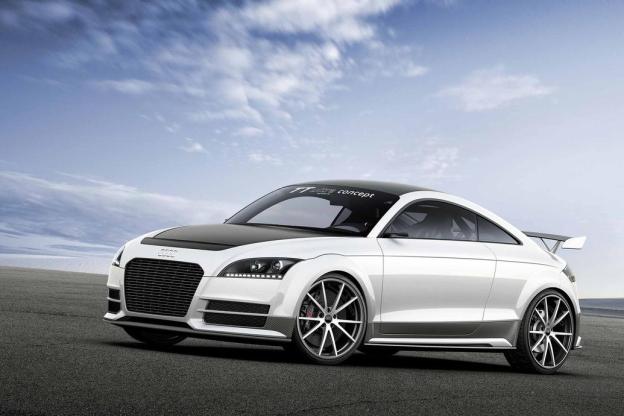 Audi has decided to make the TT a little racier. You might be thinking that the TT RS is already pretty racy, but the TT ultra quattro Concept is lighter on its feet. This ultimate TT will debut at the annual Volkswagen GTI meet in Wörthersee, Austria.
Audi has decided to make the TT a little racier. You might be thinking that the TT RS is already pretty racy, but the TT ultra quattro Concept is lighter on its feet. This ultimate TT will debut at the annual Volkswagen GTI meet in Wörthersee, Austria.
Wörthersee is where Volkswagen Group engineers let their hair down and show some insane iterations of the Group’s cars. In 2007, VW brought a mid-engined W12-powered GTI. The TT ultra, then, had better be good.
The TT ultra quattro Concept’s headline is it light weight. Audi says it’s 625 pounds lighter than the TTS on which it is based, thanks to carbon fiber (in the roof, rear end, B-pillars, and transmission tunnel), magnesium (floor) and aluminum (structure). That puts the cars curb weight at an estimated 2,650 pounds.
Audi also gave the TT ultra a more aggressive look, with a carbon fiber and aluminum rear spoiler, new wheels, a redesigned front fascia, and a titanium center-exit exhaust.

Conventional gauges were replaced with TFT displays, a preview of what we’ll see on the next production TT.
Giving the TT ultra some ultra power is a 2.0-liter turbocharged four-cylinder engine with 310 horsepower and 295 pound-feet of torque. That gives the TT ultra more power than the TTS (265 hp, 258 lb-ft), but less than the 360 hp TT RS, which has an inline-five under the hood.
The performance numbers tell the same story. The TT ultra does 0 to 60 mph in 4.2 seconds, which is faster than the TTS (4.8 seconds) but slower than the TT RS (4.1 seconds). The TT ultra’s top speed is 174 mph.
So if the lightened TT ultra is slower than the TT RS, what’s the point? For Audi, it shows how clever the company can be when it comes to lightening cars, hence all of the comparisons with TTS the concept car is based on.

However, we’ll probably never know. Since it’s based on the current TT, which is due to be replaced soon, the TT ultra has almost no chance of going into production.
Certain aspects of this concept, like the TFT gauges, will definitely show up on the next TT. We’re hoping the ultra’s more powerful 2.0-liter engine and those R8 seats are on the menu as well.


